Table of Contents
As a pet parent, you need to look for signs in your pet that will alert you to take appropriate action. If you notice the following signs, you must consult your veterinarian:
- not going up or down stairs;
- difficulty standing after lying down;
- making more noise than usual;
- not playing as much as usual;
- not willing to jump up onto surfaces;
- over-grooming or licking a particular area;
- decreased appetite.
These signs could indicate that your pet is in pain. It may either be acute or chronic.
Acute pain is sudden and usually due to an injury or surgery.
Chronic pain occurs over time due to conditions like osteoarthritis or hip dysplasia, which may go undiagnosed for many months. Osteoarthritis is a deterioration of the cartilage surrounding the bones that is progressive and permanent. It is one of the most common problems in dogs, with almost one in every five dogs having osteoarthritis. However, this disease can affect dogs of all ages and breeds and is easily overlooked in younger dogs.
In addition to the usual deterioration of joints that can occur as pets age, osteoarthritis can also be inherited (some breeds are more likely to get the condition than others), caused by dietary problems, or even brought on by lifestyle issues like being overweight or obese. Osteoarthritis is caused by wear and tear of the joints and can cause pain, swelling, and stiffness, particularly in the legs, hips, and backbone, which can restrict your dog’s activity and cause lameness. Carodyl can help relieve symptoms of osteoarthritis and improve your dog’s mobility. It also reduces pain following orthopedic and soft tissue surgery in dogs. The medicine is intended for dogs and should not be given to cats or other pets.
While osteoarthritis cannot be cured easily, some tactics can significantly slow down the disease’s development and adverse effects. The dog may limp when walking or struggle to stand up as the first symptom. The situation may worsen significantly over time.
Osteoarthritis management requires “multi-modal care.” And as a pet parent, you have lots to do to ease pain and reduce further damage to your pet’s joints.
- Recognize the symptoms of pain.
- Adopt a nutritious diet for your pet.
- Put your pet on a healthy schedule and consult your veterinarian about their needed activity.
- Regularly check your pet’s weight.
- Offer additional treatment, including the use of heat and cold pads.
Carprofen is one of eleven approved non-steroidal anti-inflammatory drugs for use in dogs that aid in the relief of inflammation, pain, and fever.
Often, it is used as a long-term pain management drug or after a surgical procedure for acute relief of pain and inflammation during the healing process. When using long-term, osteoarthritis is often the targeted condition since it is common in canine patients, varying across breed, size, and age.
The drug improves the dog’s energy, activity level, comfort, and general well-being for patients needing acute or chronic pain management.
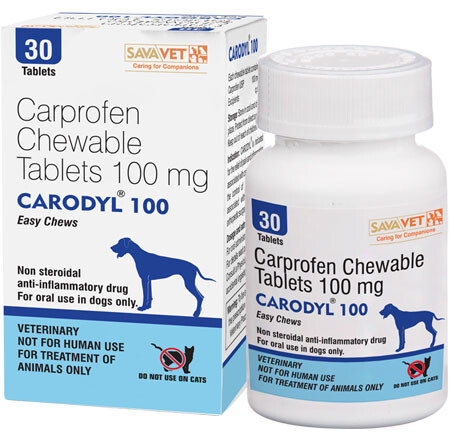
What Is Carodyl?
In India, it is the most popular NSAID brand recommended by veterinarians. This medicine has nearly eight years of clinical experience and manages canine inflammation and discomfort. It is also widely used in the postoperative recovery period when dogs have surgery. In addition, studies have shown that long-term treatment does not increase side effects while improving clinical signs of osteoarthritis in dogs. Offering flexible dosage and improved patient compliance, Carodyl is available in several strengths of 25mg, 75mg, and 100mg chewable tablets in both strips and low-cost packs of 30 tablets. Each caplet size is packaged in bottles containing 30, 60, or 180 caplets. Dogs as young as six weeks old and 120 days can be administered medication without risk.
With Carodyl, you can now beat pain confidently in your pets. So, the next time your dog suffers from joint pain, seek help from your consulting veterinarian.
It can be administered in a pill, chewable tablet, or injection form.
Injections are recommended for treating osteoarthritis-related pain and inflammation in dogs and managing the pain that follows soft tissue and orthopedic operations. The injection is intended for usage by veterinarians. If your veterinarian doesn’t advise otherwise, avoid using injections.
The pain and inflammation brought on by osteoarthritis in dogs are treated and managed with Carodyl chewable tablets.
Product Description
Carodyl (Carprofen) is a non-steroidal anti-inflammatory drug (NSAID) of the propionic acid class, including ibuprofen, naproxen, and ketoprofen. It is the nonproprietary designation for a substituted carbazole, 6-chloro-α-methyl-9H-carbazole-2-acetic acid. The empirical formula is C15H12ClNO2, and the molecular weight is 273.72.
Carprofen is a white, crystalline compound. It is freely soluble in ethanol but practically insoluble in water at 25°C.
It was initially developed for use in humans in 1988. But it was never marketed that way. While the developer said this was due to an overcrowded market, some negative feedback was circulating in the medical community around the same time.
Outside experts found unusual liver readings in 14% – 20% of test subjects. They wrote in a medical journal that “until additional data are available, older compounds should probably be tried initially.”
It was left unused for ten years before being sold to Pfizer, which gained FDA approval for its use in dogs in 1997. It became one of the first drugs for animals marketed through a multi-million dollar advertising campaign. Pfizer also offered incentives to veterinarians based on the volume they prescribed.
It became immediately popular and has remained that way to this day, most likely due to how it works compared to other NSAIDs.
By 2022 Federal law restricts this drug to use by or on the order of a licensed veterinarian.
Clinical Pharmacology
Carprofen is a non-steroidal, non-narcotic anti-inflammatory agent with characteristic analgesic and antipyretic activity approximately equipotent to indomethacin in animal models.
Like other NSAIDs, the mechanism of action is associated with inhibiting cyclooxygenase activity. Two unique cyclooxygenases have been described in mammals. The constitutive cyclooxygenase, COX-1, synthesizes prostaglandins necessary for normal renal and gastrointestinal function. The inducible cyclooxygenase, COX-2, generates prostaglandins involved in inflammation. Inhibition of COX-1 is associated with renal and gastrointestinal toxicity, while inhibition of COX-2 provides anti-inflammatory activity. The specificity of a particular NSAID for COX-2 versus COX-1 may vary from species to species.
Carprofen has also been shown to inhibit the release of several prostaglandins in two inflammatory cell systems: rat polymorphonuclear leukocytes (PMN) and human rheumatoid synovial cells, indicating inhibition of acute (PMN system) and chronic (synovial cell system) inflammatory reactions.
Several studies have reported modulatory effects on both humoral and cellular immune responses. Data also indicate that it inhibits the production of osteoclast-activating factor (OAF), PGE1, and PGE2 by its inhibitory effect on prostaglandin biosynthesis.
Peak blood plasma concentrations are achieved in 1-3 hours after oral administration of 1, 5, and 25 mg/kg to dogs. The mean terminal half-life of the medication is approximately 8 hours (range 4.5-9.8 hours) after single oral doses varying from 1-35 mg/kg of body weight. After a 100 mg single intravenous bolus dose, the dog’s mean elimination half-life was approximately 11.7 hours. This medicine is more than 99% bound to plasma protein and exhibits a minimal volume of distribution.
It is eliminated in the dog primarily by biotransformation in the liver followed by rapid excretion of the resulting metabolites (the ester glucuronide of carprofen and the ether glucuronides of 2 phenolic metabolites, 7-hydroxy Carprofen and 8-hydroxy Carprofen) in the feces (70-80%) and urine (10-20%). In addition, some enterohepatic circulation of the drug is observed.
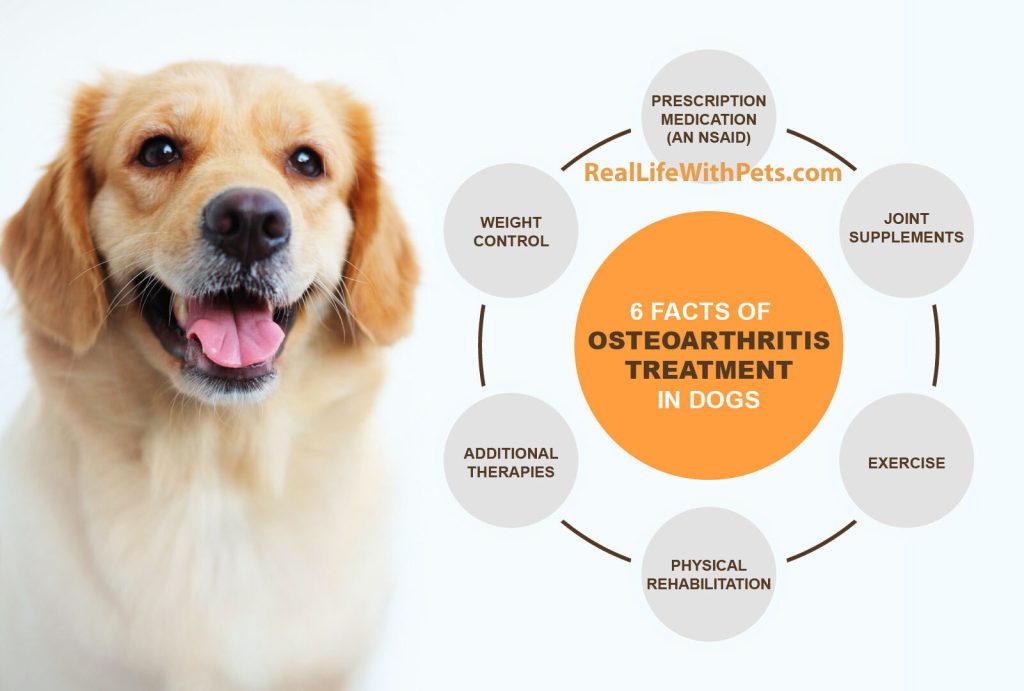
Effectiveness
The effectiveness of the medication for relieving pain and inflammation associated with osteoarthritis and for controlling postoperative pain associated with soft tissue and orthopedic surgeries was confirmed in 5 placebo-controlled, masked studies examining the anti-inflammatory and analgesic effectiveness of the medicine in various breeds of dogs.
Separate placebo-controlled, masked, multicenter field studies confirmed carprofen’s anti-inflammatory and analgesic effects when dosed at 2 mg/lb once daily or when divided and administered at 1 mg/lb twice daily. When given it at the recommended doses in these two field investigations, dogs with osteoarthritis demonstrated statistically significant overall improvement based on owner observations and veterinarian assessments of lameness.
Separate placebo-controlled, masked, multicenter field studies confirmed the effectiveness of controlling postoperative pain when dosed at 2 mg/lb once daily in various breeds of dogs. In these studies, dogs presented for ovariohysterectomy, cruciate repair, and aural surgeries were administered this medicine preoperatively and for a maximum of three days (soft tissue) or four days (orthopedic) postoperatively. In general, dogs administered the pills showed statistically significant improvement in pain scores compared to controls.
Composition
Carodyl is produced in the form of chewable tablets containing either 25, 75, or 100 mg of carprofen and additional excipients in each tablet. So there are three variants provided by the manufacturer:
- Carodyl 25 mg.
- Carodyl 75 mg.
- Carodyl 100 mg.
The chewable tablets contain the active ingredient carprofen, a non-steroidal anti-inflammatory drug (NSAID) used to treat pain and inflammation due to osteoarthritis and surgery in dogs.
Uses of Carodyl
Carprofen is an agent with analgesic and antipyretic properties. It is a non-steroidal as well as non-narcotic drug. The healing effect for dogs can be compared to another popular drug in veterinary medicine –indomethacin.
It is one of the most widely used medications in veterinary medicine. This makes it ideal for use in musculoskeletal injury treatment and postoperative care. But mainly, it is used to treat symptoms of osteoarthritis: sharp pain and inflammation.
It is used short-term as long as pain and discomfort bother your dog. Either way, it can also be used for long-term relief of osteoarthritis, hip dysplasia, and various types of joint deterioration.
Dosage Sizes
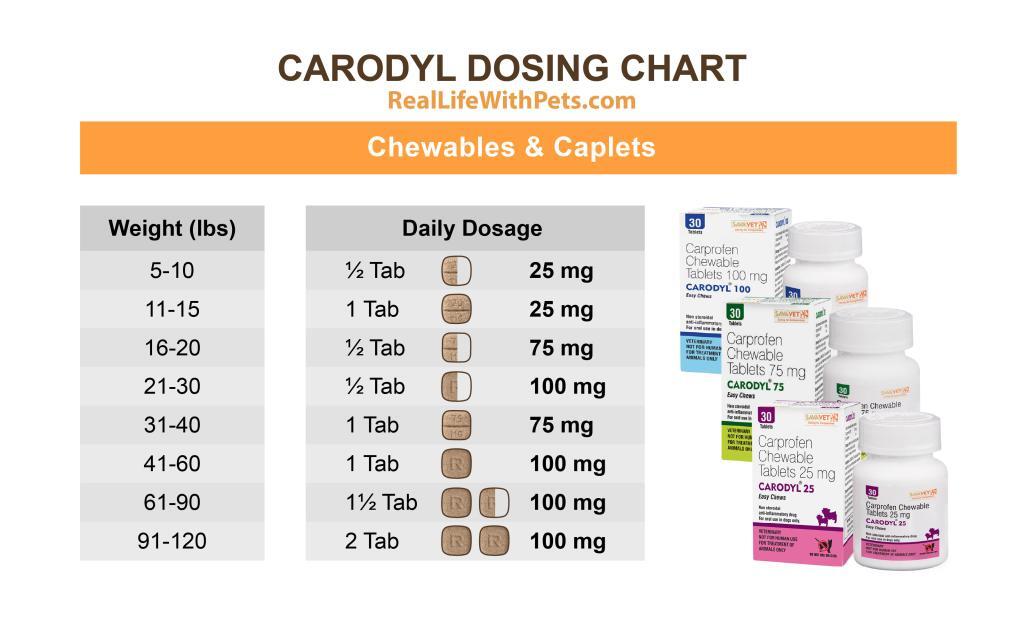
Carefully consider the potential benefits and risks of the medicine and other treatment options before deciding to use it. Use the lowest effective dose for the shortest duration consistent with individual response.
Carodyl should be administered orally to your dog along with meals. Two equally divided doses of 2-4mg per kilogram of body weight (2.2lb) each day are advised. After a week, the dosage may be decreased to once daily based on your dog’s response and the advice of your veterinarian. Within a few days, improvement ought to be evident. It would be best if you continued giving medicine to your dog for as long as your veterinarian advised, which might be a very long time. Carodyl will alleviate your dog’s osteoarthritis symptoms but won’t reverse the condition.
To control postoperative pain, administer approximately 2 hours before the procedure. The chewable tablets are scored, and dosage should be calculated in half-tablet increments. Tablets can be halved by placing the tablet on a hard surface and pressing down on both sides of the score. Care should be taken to ensure that the dog consumes the complete dose.
To correctly calculate the dosage, you need to contact a veterinarian.
It should be given at around the same time each day.
Speaking about the connection with food, it doesn’t matter how you give it to your dog: either add it to the dog’s favorite food or put it straight into its mouth separately.
If you miss a dose, give it as soon as you remember, unless it is time to give the next dose, then skip the missed dose. Do not give a double dose.
Withdrawal Times
When you give the medication to your dog, he absorbs about 90% of it. After using any oral dose, ranging from 1 up to 35 mg/kilo of weight, the average withdrawal period varies within 4-8 hours. For example, after giving a single 100mg tablet at once, its half-time elimination would take nearly half a day (12 hours).
Important Safety Information for Dog Owners
Carodyl, like other medications in its class, can have risks associated with adverse reactions. Therefore, before providing it, owners should let a veterinarian know if there have been any instances of drug intolerance.
Like other medications in its class, it can have adverse effects. Owners should be aware of the possibility of negative responses and the clinical symptoms linked to drug intolerance.
Lethargy, incoordination, seizure, decreased appetite, vomiting, diarrhea, dark or tarry stools, pale gums from anemia, yellowing of the gums, skin, or whites of the eyes from jaundice, increased water consumption, increased urination, and behavioral changes are just a few examples of adverse reactions. When the symptoms are identified, the treatment is stopped, and veterinary care, if necessary, is started, most patients who experience drug-related adverse reactions recover. Owners of all dogs should be informed of the value of routine follow-up care while administering any NSAID.
The medicine is well tolerated in dogs following oral treatment, as shown by laboratory research in unanesthetized dogs and clinical field trials.
Severe adverse reactions associated with this drug class can occur without warning and, in rare situations, result in death. Therefore, owners should be advised to discontinue Carprofen therapy and immediately contact their veterinarian if intolerance is observed.
Talk to your veterinarian if you have questions or concerns about the medication, osteoarthritis, or postoperative pain.
As with all prescribed medicines, it should only be given to the dog for which it was prescribed.
It is important to periodically discuss your dog’s response to treatment at regular check-ups. Your veterinarian will best determine if your dog is responding as expected and if your dog should continue receiving the medicine.
Is Carodyl Safe for Dogs?
Numerous scientific types of research have approved general effectiveness and safety for dogs, held mainly in the USA. The medication is, therefore, safe when used cautiously and following the veterinarians’ instructions and recommended dosage. However, potential therapeutic side effects are still risks based on your dog’s particular health conditions.
Laboratory studies in unanesthetized dogs and clinical field studies have demonstrated that medicine is well tolerated in dogs after oral administration.
In target animal safety studies, the medication was administered orally to healthy Beagle dogs at 1, 3, and 5 mg/lb twice daily (1, 3, and 5 times the recommended daily dose) for 42 consecutive days with no significant adverse reactions. Serum albumin for a single female dog receiving 5 mg/lb twice a day decreased to 2.1 g/dL after two weeks of treatment, returned to the pre-treatment value (2.6 g/dL) after four weeks, and was 2.3 g/dL at the final 6-week evaluation. Over the 6-week treatment period, black or bloody stools were observed in 1 dog (1 incident) treated with 1 mg/lb twice daily and in 1 dog (2 incidents) treated with 3 mg/lb twice daily. In addition, redness of the colonic mucosa was observed in 1 male that received 3 mg/lb twice daily.
Two of 8 dogs receiving 10 mg/lb orally twice daily (10 times the recommended total daily dose) for 14 days exhibited hypoalbuminemia. The mean albumin level in the dogs receiving this dose was lower (2.38 g/dL) than in 2 placebo control groups (2.88 and 2.93 g/dL, respectively). Three incidents of black or bloody stool were observed in 1 dog. Five of 8 dogs exhibited reddened areas of duodenal mucosa on gross pathologic examination. Histologic examination of these areas revealed no evidence of ulceration but showed minimal lamina propria congestion in 2 of the five dogs.
In separate safety studies lasting 13 and 52 weeks, dogs were administered orally up to 11.4 mg/lb/day (5.7 times the recommended total dose of 2 mg/lb). In both studies, the drug was well tolerated clinically by all animals. No gross or histologic changes were seen in any of the treated animals. In both studies, dogs receiving the highest doses had average increases in serum L-alanine aminotransferase (ALT) of approximately 20 IU.
In the 52-week study, minor dermatologic changes occurred in dogs in each treatment group but not in the control dogs. The changes were described as slight redness or rash and were diagnosed as non-specific dermatitis. Therefore, the possibility exists that these mild lesions were treatment related, but no dose relationship was observed.
Clinical field studies were conducted with 549 dogs of different breeds at the recommended oral doses for 14 days (297 dogs were included in a study evaluating 1 mg/lb twice daily, and 252 dogs were included in a separate study evaluating 2 mg/lb once daily). The drug was clinically well tolerated in both studies, and the incidence of clinical adverse reactions for carprofen-treated animals was no higher than for placebo-treated animals (placebo contained inactive ingredients found in Carprofen caplets). For animals receiving 1 mg/lb twice daily, the mean post-treatment serum ALT values were 11 IU greater and 9 IU less than pre-treatment values for dogs receiving carprofen and placebo, respectively. Differences were not statistically significant. For animals receiving 2 mg/lb once daily, the mean post-treatment serum ALT values were 4.5 IU greater and 0.9 IU less than pre-treatment values for dogs receiving carprofen and placebo, respectively. In the latter study, three carprofen-treated dogs developed a 3-fold or more significant increase in (ALT) and/or (AST) during therapy. One placebo-treated dog had a greater than 2-fold increase in ALT. None of these animals showed clinical signs associated with the laboratory value changes. Therefore, changes in clinical laboratory values (hematology and clinical chemistry) were not considered clinically significant. The 1 mg/lb twice-a-day course of therapy was repeated at 2-week intervals in 244 dogs, some for as long as five years.
Clinical field studies were conducted on 297 dogs of different breeds undergoing orthopedic or soft tissue surgery. Dogs were administered 2 mg/lb two hours before surgery, then once daily, as needed for two days (soft tissue surgery) or three days (orthopedic surgery). The medication was well tolerated when used in conjunction with various anesthetic-related drugs. The type and severity of abnormal health observations in carprofen- and placebo-treated animals were approximately equal. The most frequent abnormal health observation was vomiting, observed at approximately the same frequency in carprofen- and placebo-treated animals. Changes in clinicopathologic indices of hematopoietic, renal, hepatic, and clotting function were not clinically significant. The mean post-treatment serum ALT values were 7.3 IU and 2.5 IU less than pre-treatment values for dogs receiving carprofen and placebo, respectively. The mean post-treatment AST values were 3.1 IU less for dogs receiving Carprofen and 0.2 IU greater for dogs receiving a placebo.
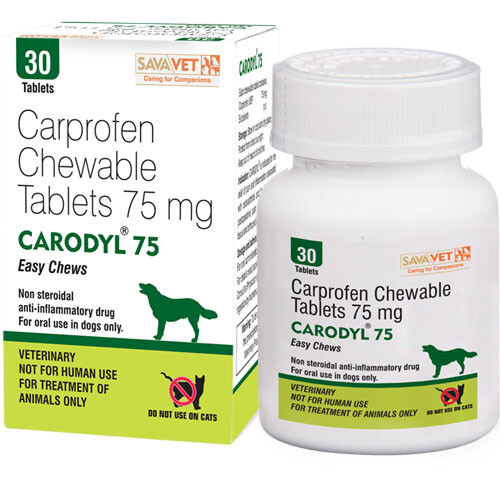
Palatability
The chewable tablets are palatable and willingly consumed by most dogs when offered by the owner. Therefore, they may be fed by hand or placed on food. They may be given with or without food, but giving with food reduces the chances of stomach upset. If vomiting occurs when dosed on an empty stomach, give future doses with food or a treat.
The pills are available in meaty flavored chewable tablets that are more palatable and easier for dogs to swallow.
Veterinary Prescription
It is better if the veterinarian prescribes the drug. Before starting treatment, baseline bloodwork and urinalysis should be performed by your veterinarian. For long-term use, liver enzymes and kidney values should be checked 2 to 4 weeks after starting the medication and then every 3 to 6 months during therapy. Then, at home, monitor for serious side effects, discontinue the medication, and contact your veterinarian if these occur. In addition, your veterinarian may monitor your pet to ensure the medication works.
Contraindications and Warnings
The medication should not be given with other NSAIDs (for example, aspirin, deracoxib, etodolac, firocoxib, meloxicam, tepoxalin) or steroids (for example, cortisone, dexamethasone, prednisone, triamcinolone). Tell your veterinarian about all medicines you have given your dog in the past and any medicines you plan to give. This should include other medicines that you can get without a prescription. Your veterinarian should check that all your dog’s medicines can be given together.
The following medications should be used with caution when given with carprofen: anticoagulants, ACE inhibitors, aspirin or other NSAIDs, corticosteroids, cyclosporine or other nephrotoxic medications, dacarbazine, dactinomycin, desmopressin, digoxin, dinoprost, highly protein bound medications, insulin, oral antidiabetics, loop diuretics, methotrexate, or tricyclic antidepressants.
It is forbidden to use Carodyl with antibiotics and other drugs with similar and close effects: aspirin, tepoxalin, etodolac.
Also, you can’t use it with prednisone, cortisone, or other steroidal drugs.
Talk to your veterinarian about the following:
- the signs of OA you have observed in your dog;
- the importance of weight control and exercise in the management of OA;
- what tests might be done before medication is prescribed;
- how often your dog may need to be examined by your veterinarian;
- the risks and benefits of using the drug.
You should not use the medication if your dog:
- has a sensitivity reaction to carprofen or any other NSAID or any ingredients in the drug;
- is younger than six months;
- is pregnant or lactating;
- has a heart condition, liver or kidney disease, or bleeding disorders;
- has been given other NSAID medication, corticosteroids, heart drugs (ACE inhibitors), and some drugs for seizure control;
- has had an allergic reaction to aspirin or other NSAIDs (for example, deracoxib, etodolac, firocoxib, meloxicam, phenylbutazone, or tepoxalin) such as hives, facial swelling, or red or itchy skin;
- has digestive upset (vomiting and/or diarrhea);
- has any other medical problems or allergies your dog has now or has had.
It should be given to dogs only. Cats should not be given the medication. Call your veterinarian immediately if your cat ate the drug. Likewise, people should not take medicine. Keep it and all medicines out of reach of children. Call your physician immediately if you accidentally take the drug.
Warnings
Before getting your veterinarian’s approval, don’t adjust the dosage (either to a higher or lower level). The dosage amount is often determined by the severity of the illness in the individual case, the dog’s present state of health, and their medical history. Because of this, only a professional can recommend an exact dosage.
For routine check-ups, don’t hesitate to contact your veterinarian. It can let you see exactly how a dog reacts to treatment. In this way, the veterinarian can determine if the prescribed medication effectively resolves the initial issue or whether a change in the course of action is necessary.
Before beginning NSAID therapy, all dogs should go through a complete history and physical examination. In addition, before and frequently throughout the administration of any NSAID, appropriate laboratory tests to establish baseline hematological and serum biochemical data should be considered.
Owners should be instructed to look for indications of possible drug toxicity.
Studies have not been conducted to determine the activity of the drug when administered concomitantly with other protein-bound or similarly metabolized drugs. Therefore, drug compatibility should be monitored closely in patients requiring additional therapy. Such drugs commonly used include cardiac, anticonvulsant, and behavioral medications. In addition, such treatment may reduce the inhalant anesthetics needed.
Consider appropriate washout times when switching from one NSAID to another or from corticosteroid to NSAID use.
Due to the palatable nature of Carodyl chewable tablets, keep the medication in a secure location. Severe adverse reactions may occur if large quantities of tablets are ingested. If you suspect your dog has consumed more than prescribed, please call your veterinarian for immediate assistance.
As a class, cyclooxygenase-inhibitory NSAIDs may be associated with gastrointestinal, renal, and hepatic toxicity. Effects may result from decreased prostaglandin production and inhibition of the enzyme cyclooxygenase, which is responsible for the formation of prostaglandins from arachidonic acid. When NSAIDs inhibit prostaglandins that cause inflammation, they may also inhibit those prostaglandins which maintain normal homeostatic function. These anti-prostaglandin effects may result in clinically significant disease in patients with underlying or pre-existing disease more often than in healthy patients. NSAID therapy could unmask occult disease, which has previously been undiagnosed due to the absence of apparent clinical signs. For example, patients with underlying renal disease may experience exacerbation or decompensation of their renal disease while on NSAID therapy. Parenteral fluids during surgery should be considered to reduce the potential risk of renal complications when using NSAIDs perioperatively.
Sensitivity to drug-associated adverse reactions varies with the individual patient. Dogs that have experienced adverse reactions from one NSAID may experience adverse reactions from another NSAID. Carprofen treatment was not associated with renal toxicity or gastrointestinal ulceration in well-controlled safety studies of up to ten times the dose in dogs. 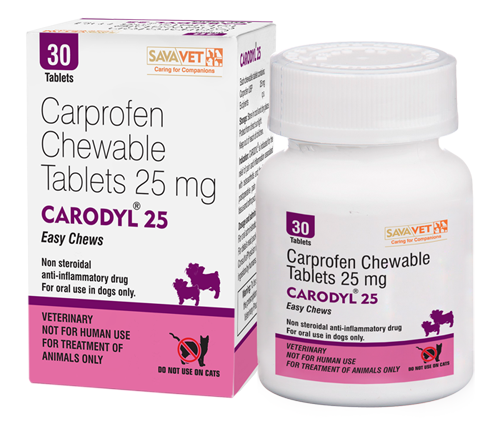
Side Effects
The drug is not free from side effects. If you notice anything from the list below after starting the drug, visit your vet immediately to inform him about the occurrence. So the list of possible side-effects comes as follows:
- vomiting;
- diarrhea;
- appetite decreasing;
- stool problems, tarry or dark stool;
- general weakness and tiredness;
- urination level increase;
- anemia;
- behavior changes (decreased or increased activity level or aggression);
- incoordination, strange moves;
- gastritis or ulcer formation;
- seizure and convulsions;
- kidney or liver damage;
- paralysis (part or full);
- scabs;
- itching;
- increased thirst;
- increased urination;
- yellowing of gums, skin, or whites of the eyes (jaundice).
The most commonly reported side effects when taking the medication include; vomiting, diarrhea, loss of appetite, lethargy, and behavioral changes.
Serious side effects can occur with or without warning and, in rare situations, result in death.
It is important to stop therapy and contact your veterinarian immediately if you think your dog has a medical problem or side effect from the drug. Likewise, talk to your veterinarian if you have additional questions about possible side effects.
Side Effects Studies
No clinically significant adverse reactions were reported during investigational studies of osteoarthritis with twice-daily administration of 1 mg/lb. However, some clinical signs were observed during field studies (n=297), similar for Carprofen caplet- and placebo-treated dogs. Incidences of the following were observed in both groups: vomiting (4%), diarrhea (4%), changes in appetite (3%), lethargy (1.4%), behavioral changes (1 %), and constipation (0.3%). The product vehicle served as control.
No serious adverse events were reported during clinical field studies with once-daily oral administration of 2 mg/lb. However, the following categories of abnormal health observations were reported. The product vehicle served as control.
| Percentage of Dogs with Abnormal Health Observations Reported in Clinical Field Study (2mg/lb once a day) | ||
| Observation | Carprofen (n=129) | Placebo (n=132) |
| Vomiting | 3.1 | 3.8 |
| Inappetence | 1.6 | 1.5 |
| Diarrhea/Soft stool | 3.1 | 4.5 |
| Dermatitis | 0.8 | 0.8 |
| Behavior Change | 0.8 | 0.8 |
| PU/PD | 0.8 | – |
| ALT Increase | 5.4 | 4.5 |
| SAP Increase | 7.8 | 8.3 |
| AST Increase | 2.3 | 0.8 |
| BUN Increase | 3.1 | 1.5 |
| Ketonuria | 14.7 | 9.1 |
| Bilirubinuria | 16.3 | 12.1 |
Clinical pathology parameters represent reports of increases in pre-treatment values; medical judgment is necessary to determine clinical relevance.
No clinically significant adverse reactions were reported during investigational studies of surgical pain for the caplet formulation. The product vehicle served as control.
|
Percentage of Dogs with Abnormal Health Observations Reported in Surgical Pain Field Studies with Caplets (2 mg/lb once daily) |
||
| Observation | Carprofen (n=148) | Placebo (n=149) |
| Diarrhea/Soft stool | 6.1 | 6.0 |
| Vomiting | 10.1 | 13.4 |
| Ocular Disease | 2.7 | 0 |
| Dermamitis/Skin lesion | 2.0 | 1.3 |
| Inappetence | 1.4 | 0 |
| Dysrhythmia | 0.7 | 0 |
| Oral/Periodontal Disease | 1.4 | 0 |
| Apnea | 1.4 | 0 |
| Pyrexia | 0.7 | 1.3 |
| Wound Drainage | 1.4 | 0 |
| Urinary Tract Disease | 1.4 | 1.3 |
Although not all adverse reactions are reported, the following adverse reactions are based on voluntary post-approval adverse drug experience reporting. The categories of adverse reactions are listed in decreasing order of frequency by the body system. More serious side effects include liver, kidney, or gastrointestinal damage characterized by severe vomiting, diarrhea, black or bloody stools, bloody vomit, increased drinking and/or urination, yellow skin or eyes, severe lethargy, and persistent lack of appetite.
- Gastrointestinal: Vomiting, diarrhea, constipation, inappetence, melena, hematemesis, gastrointestinal ulceration, gastrointestinal bleeding, pancreatitis.
- Hepatic: Inappetence, vomiting, jaundice, acute hepatic toxicity, hepatic enzyme elevation, abnormal liver function test(s), hyperbilirubinemia, bilirubinuria, hypoalbuminemia. Approximately one-fourth of hepatic reports were in Labrador Retrievers.
- Neurologic: Ataxia, paresis, paralysis, seizures, vestibular signs, disorientation.
- Urinary: Hematuria, polyuria, polydipsia, urinary incontinence, urinary tract infection, azotemia, acute renal failure, tubular abnormalities including acute tubular necrosis, renal tubular acidosis, glucosuria.
- Behavioral: Sedation, lethargy, hyperactivity, restlessness, aggressiveness.
- Hematologic: Immune-mediated hemolytic anemia, immune-mediated thrombocytopenia, blood loss anemia, epistaxis.
- Dermatologic: Pruritus, increased shedding, alopecia, pyotraumatic moist dermatitis (hot spots), necrotizing panniculitis/vasculitis, ventral ecchymosis.
- Immunologic or hypersensitivity: Facial swelling, hives, erythema.
In rare situations, death has been associated with some of the abovementioned adverse reactions.
Overdose
Overdose in dogs is undoubtedly possible, and the consequences can be severe. Doses of 10 milligrams per pound or more frequently result in severe nausea, diarrhea, and vomiting. In addition, carprofen poisoning can cause paralysis, tremors, convulsions, GI perforation, and kidney failure if left untreated.
The most typical kind of overdose occurs when a dog consumes an entire bottle of chewable pills. Visit your veterinarian or go to an animal emergency clinic. Bring the remaining pill bottle and additional information about the drug’s strength and dosage.
If your dog accidentally gets a small overdose (like one or two extra tablets), contact your vet or an animal poison control service. You may be advised to induce vomiting if the overdose happened recently. Some dogs will still need follow-up treatment at a veterinary hospital.
Keep this drug and other medications out of your dog’s reach to prevent accidental overdose. Ensure all home members understand the dosing instructions and schedule if they will be involved in feeding/medication times.
Contact your veterinarian immediately if your dog eats more than the prescribed amount of the drug.
In dogs, toxicity can be seen with 22 mg/kg doses. Long-term use, even at therapeutic doses, can result in clinical signs of toxicity.
Poisoning
Cats cannot use this medicine, according to the FDA. When consumed in lethal doses, it can cause severe stomach ulcers and abrupt kidney failure in dogs and cats. Vomiting, diarrhea, bloody vomitus, black-tarry stools, loss of appetite, lethargy, increased urine or thirst, general malaise, abdominal discomfort, liver damage with high dosages, and seizures or death are all symptoms of poisoning. Rarely, even without an overdose, it can cause liver damage in dogs with prolonged intake.
Call your veterinarian and the Pet Poison Helpline immediately for advice on life-saving treatments if you think an NSAID may have poisoned your dog or cat. The sooner you get this treated, the less expensive and risky it is for your pet!
Storage
The medicine can be kept in a storage area away from direct sunlight and at room temperature between 15 and 30 C. Additionally, be sure that children cannot access it.
Benefits of Using Carodyl
- Faster pain relief in degenerative joint disease bone, muscle & joint disorders, pre and post-joint surgery.
- Non-Steroidal.
- Decreases inflammation.
- Tablets with a meat flavor for improved flavor.
Drugs Similar to Carodyl
Carprofen is marketed under many brand names, including Acticarp, Artriofin, Austiofen, Aventicarp, Bomazeal, Canidryl, Corporal, Carprieve, Carprocow, Carprodolor, Carprodyl, Carprofelican, Carprofen, Carprofène, Carprofeno, Carprofenum, Carprogesic, Carprosol, Carprotab, Carprox, Comforion, Dolagis, Dolocarp, Dolox, Eurofen, Kelaprofen, Levafen, Librevia, Norocarp, Norodyl, Novocox, Novox, Ostifen, Prolet, Quellin, Reproval, Rimadyl, Rimifin, Rofeniflex, Rovera, Rycarfa, Scanodyl, Tergive, Vetprofen, Xelcor, and Zinecarp.
FAQs
Where to Buy the Drug?
In 2022 you can buy it at many veterinary drug stores if you have a prescription. In addition, it is available at an affordable price.
Do I Need a Prescription?
Yes, it is a prescription drug, so you can get it only if your vet prescribes it. Contact your veterinarian first to discuss the symptoms of your pet.
How Long Should I Give Carodyl?
Everything depends on the reasons to use it (initial problem), the current health state of your dog, and its peculiarities. Your vet will give all the necessary instructions.
Where Is This Medicine Produced?
The drug is initially produced in India by the company SAVA Vet.
What Results Can I Expect When My Dog Is on Treatment?
Osteoarthritis cannot be cured; however, the drug can help your dog move more easily by reducing OA discomfort and inflammation. Dogs’ reactions differ but can be dramatic. In most dogs, improvement can be observed within a few days. However, your dog’s discomfort and inflammation can return if you stop using the medication or don’t administer it as prescribed.
Can I Give My Dog Ibuprofen Instead of Carprofen?
Do not give your dog ibuprofen or acetaminophen. This medicine is one of the available NSAIDs just for dogs. Contact your vet if you want to change the NSAID.
Is This Drug Stronger Than Ibuprofen?
Both are anti-inflammatory and analgesic drugs. But in terms of potency, Carodyl is in the middle of the NSAID range, roughly five times as potent as ibuprofen, milligram for milligram.
How Long Does It Take for Carodyl to Kick in for Dogs?
Active ingredient reduces inflammation expressed by COX enzymes. It starts working within 1 to 2 hours after administration. Youthful energy and comfort return with clinical improvements after a few days.
Is This Drug the Same as Gabapentin?
This medication controls pain and inflammation, while gabapentin acts on neurological pain. If they are to be given chronically, bloodwork must be monitored, especially for the first one. It can have serious side effects on the liver and kidneys. Typically a blood sample is drawn before starting and then a month after use.
Is Carprofen the Same as Tramadol?
By 2022 study suggests that this drug, with opioid premedication, provides more effective postoperative analgesia than tramadol in dogs undergoing enucleation.
Will Carodyl Make My Dog Sleepy?
Yes, it does make some dogs tired. However, as long as your dog isn’t suffering from severe lethargy, this usually isn’t a cause for concern.
Can I Stop Giving My Dog Carodyl?
The medication, unlike steroids, can be stopped without weaning off the dog. Just stop giving the dose if the veterinarian recommends it.
Can The Drug Cause Kidney or Liver Failure in Dogs?
Serious but rare side effects have been reported in dogs taking NSAIDs. Serious side effects can occur with or without warning and, in rare situations, result in death. The most common NSAID-related side effects involve the stomach (such as bleeding ulcers) and liver or kidney problems.
Does Carodyl Cause Panting In Dogs?
Panting isn’t one of the side effects of the drug in dogs. But if your dog is panting excessively after taking it, you should contact your vet. It may be a sign of another disease.
What Color Is the Pill for Dogs?
It is a white, crystalline compound, freely soluble in ethanol but practically insoluble in water at 25°C.
Can I Crush the Pill for Dogs?
Since tablets are oblong, they are easy to split in half. Contact your veterinarian to get more information about the dosage for your dog.
Can You Use Expired Medicine for Dogs?
As a general rule, you should discard any liquid medication two weeks after mixing and discard any pills or capsules six months after dispensing. Clean your medicine box twice a year and discard any expired products. Certain expired medications are at risk of bacterial growth, and sub-potent antibiotics can fail to treat infections, leading to more severe illnesses and antibiotic resistance. In addition, once the expiration date has passed, there is no guarantee that the medicine will be safe and effective.
Can I Give My Dog Carprofen And Benadryl?
Yes, it is generally safe to give these medications together. But before doing this, please get approval from your veterinarian because he knows your dog’s medical history.
Can You Mix This Drug and Trazodone for Dogs?
Both drugs can be used together, but we advise against giving them simultaneously to avoid stomach upset. Instead, contact your vet because he knows your pet’s medical history; he may suggest what to do.
Can I Give This Medication to a Dog with Pancreatitis?
Yes, it can be given to a dog with pancreatitis. However, vomiting can occur in approximately 4% of the time it is taken. If any side effects occur, contact the veterinarian to get more information.
Does Carodyl Reduce Fever in Dogs?
Yes, vets may prescribe this medication for short-term use in dogs with fevers. It can manage acute pain and inflammation, keeping dogs more comfortable as they recover.
Can You Give Carodyl to a Nursing Dog?
This medicine has not been tested in pregnant or nursing females and thus is not recommended for use in such individuals, mainly since COX-2 is vital in reproductive function. In addition, it should not be used in dogs with pre-existing liver or kidney disease.
Can I Give Carodyl to My Dog After Surgery?
Yes, you can. It is a prescription drug for dogs that can reduce pain after surgery.
Can You Give Metacam and Carodyl Together?
You shouldn’t give these two medicines together. Be sure to tell your veterinarian about any other medications your dog takes before beginning treatment with Carodyl.
Is Deramaxx a Carprofen?
They are both NSAIDs, but they are different medicines. There are several commercially available veterinary NSAIDs, including carprofen (Carodyl), deracoxib (Deramaxx), meloxicam (Metacam), etodolac (Etogesic), tepoxalin (Zubrin), and robenacoxib (Onsior).
Can I Give My Dog Carodyl and Prednisone Together?
It is better to allow at least one week between prednisone and carprofen. You should consult your vet to get more detailed information.
Is Carodyl Better Than Aspirin for Dogs?
This drug is frequently used to treat osteoarthritis and is usually better tolerated by dogs than aspirin. Contact your veterinarian if you want to change the prescribed NSAID.
What Painkiller Can I Give My Dog for Toothache?
There are some available NSAIDs just for dogs: carprofen (Carodyl), deracoxib (Deramaxx), and firocoxib (Previcox). Choose the one that is better tolerated by your pet. Consult the vet if you need help. Additional tests may be needed.
Can I Give My Dog This Drug for Cancer Pain?
This medicine may be helpful when used with other chemotherapy drugs to treat some types of cancer in dogs. The FDA (U.S. Food & Drug Administration) has approved this drug for use in dogs. For dogs with cancer, use only prescribed drugs. Contact the vet who knows the animal’s medical history for more details.

































